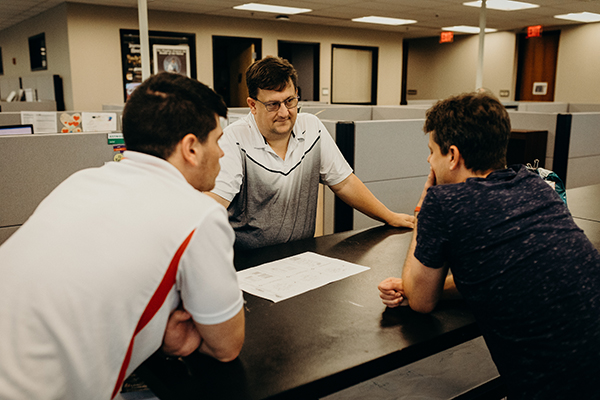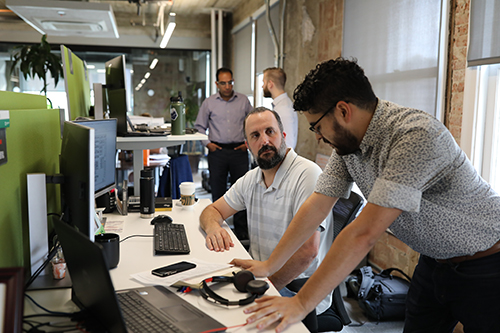The Labor Forces Transforming the Plumbing Engineering Profession
An industry searches for solutions amid a historic personnel crunch.

On a chilly Thursday morning last November, representatives from the Kansas City (Mo.) Chapter of the American Society of Plumbing Engineers (ASPE) set out on a two-hour drive westward to the picturesque Flint Hills region in eastern Kansas. Their destination was the town of Manhattan, Kan., home to Kansas State University (K-State), where ASPE was hosting a student seminar at the Carl R. Ice College of Engineering.
The agenda was typical of professional organizations engaging with higher education institutions: to preach the gospel of the joys and opportunities present in the plumbing engineering profession.
Perched up on stage in front of 200 or so students, ASPE member and K-State alum Mike Monthey, a 19-year industry veteran and plumbing technical director at Henderson Engineers, kicked off his presentation with a simple question: “How many of you are interested in becoming plumbing engineers?” His inquiry was met with silence as not a single attendee voiced intent or raised hands. While this reception could have been demoralizing, Monthey surprisingly felt otherwise.
“I’m an architectural engineer by training, but I ended up practicing as a plumbing engineer because I saw it as a specialization that could pretty much guarantee a great, impactful living for my entire career,” he says. “It’s not a question of whether there’s opportunity in our industry; it’s a matter of making sure that people know about it and giving them the tools and support to succeed.”
An Industry Under Pressure
That the students’ reaction, or lack thereof, didn’t faze Monthey gets at the heart of a variety of factors making plumbing engineering a challenging yet opportune specialty. Perhaps most striking is a historic labor crunch present in many American industries in the post-COVID-19 pandemic era.
The American Council of Engineering Companies (ACEC), a national association representing more than 5,500 engineering firms, releases a quarterly Engineering Business Sentiment Study outlining the state of the engineering sector. The sentiment study from the third quarter of 2023, the latest available as of press time, found that 52% of firms are turning down work due to worker shortages and 73% of companies note that a shortfall of skilled workers is the largest obstacle to growing their business (https://programs.acec.org/impact-report-21/).

ACEC’s findings are borne out by the overall picture of the U.S. economy, based on the most recently available figures from the federal government. While the August 2023 unemployment rate for all occupations was 3.9%, the unemployment rate for architecture and engineering occupations was notably lower at 2.6%, as reported by the U.S. Bureau of Labor Statistics (https://bit.ly/3r1vVGZ).
“Things may seem dire, but the synonym for labor shortage is an abundance of opportunity both in terms of projects and jobs available,” Monthey explains. “There isn’t a single engineering trade organization or company whose primary focus isn’t on how to attract and retain talented individuals to our industry. This has been true for quite some time, but the current climate is unlike anything we’ve seen before.”
Building From the Ground Up
Hence ASPE’s presence at K-State, where Monthey had a winning strategy up his sleeves. Expectedly, his speech generally highlighted his successful career path as well as interesting projects he’s worked on to illustrate the possibilities within the field.
However, to make it relatable to the students at hand, he dove into various notable projects that Henderson Engineers had worked on specifically at the K-State campus, including the Ice Family Basketball Center and the Bill Snyder Family Stadium, home of the university’s beloved Big 12 Conference football team.
His charm offensive also discussed how plumbing designers and engineers can benefit communities through sustainable strategies such as low-flow water fixtures and rainwater harvesting. This approach seemed to make inroads.
“I paused around halfway through my presentation and asked how many students want to save water and started getting some hands raised, so the impact of choosing to engage with them by focusing on what they care about was immediately clear,” Monthey says. “You could see them perk up when I mentioned familiar buildings where many of them had spent time in.”
He explained that plumbing engineering is somewhat disadvantaged by its designation as a subdiscipline of mechanical engineering: “Many engineering students attend schools where plumbing isn’t a significant focus or a focus at all, so they’re much more comfortable pursuing jobs designing HVAC systems after graduating. This needs to change if we’re to successfully address our workforce shortfalls.”
As such, a decades-long push exists within the education system to expand plumbing engineering’s visibility. When it announced its first-of-its-kind plumbing engineering-specific curriculum in 1952, Los Angeles City and State Colleges published a detailed pamphlet including testimonials from the who’s who of the California plumbing industry. Their common refrain touted prosperity as the selling point.
Since then, several universities nationwide have introduced plumbing design certificates as part of their elective or continuing education coursework — including prestigious institutions such as the University of California-Los Angeles and New York University.
With support from advocates like Monthey, institutions such as K-State are further leaning into plumbing engineering through partnerships. The university is currently in the early stages of launching an ASPE student chapter to expand its plumbing engineering programming.
“Our ultimate goal is to prepare students for successful careers after college,” notes Jake Hamilton, assistant professor at K-State who helps spearhead plumbing engineering courses. “Plumbing engineering has been taught much in the same way for decades, so we’re focused on evolving our approach by highlighting the present needs of the industry.
“We love collaborating with companies and industry organizations such as ASPE to stay plugged in on the latest trends. Sustainability, in particular, seems to make inroads with today’s students. Hosting experts in the field on campus helps inspire them because they can hear firsthand from individuals who enjoy plumbing design.”
While exposure to plumbing engineering is crucial, Monthey says that educational institutions also should be keen to focus on long-term prosperity as a selling point. It’s advice that would seemingly resonate with Gen Z graduates joining the workforce, 85% of whom say job stability is their top priority, according to a 2023 report by Handshake, an online networking and recruiting platform serving students and alumni from more than 1400 educational institutions (https://bit.ly/3Z6QsGw).
This surpasses other key driving forces such as salary and benefits.
“It’s important to remember that people pursue careers not only out of passion or wanting to have an impact, but also with a desire to support themselves and their loved ones well into the future,” Monthey explains. “It was true in the 1950s, it’s true now, and it will likely remain true for decades down the road.”

Building From Within
While the efforts being undertaken by educational institutions are commendable, time is their biggest obstacle in solving the immediate labor shortfall. Students, after all, must spend years earning their degrees and learning the ropes of the industry upon joining the labor pool. Plumbing engineering must, therefore, be lauded as a viable alternative for early-to-mid career professionals who are practicing in other disciplines and may be open to a career change.
As previously mentioned, plumbing engineering isn’t a standalone discipline but rather a subset of mechanical engineering. Like many professions, nondegree credentials can positively impact career advancement and earnings, with the Professional Engineer (PE) license being the epitome of qualifications. In fact, the American Society of Mechanical Engineers reports that earning a PE can increase one’s earnings by 10-to-15% (https://bit.ly/3PbTGE6).
To earn a PE, a mechanical engineer has the option of taking the Mechanical Engineering Principles and Practice (MEPP) exam, administered by the National Council of Examiners for Engineering and Surveying (NCEES) in three different versions: HVAC and Refrigeration, Mechanical Systems and Materials, or Thermal and Fluid Systems. Notably missing from these options is an examination focused on plumbing engineering.
“When many up-and-coming mechanical engineers are establishing themselves in the building industry, it’s much more enticing to go into HVAC design because the systems are in place to support that decision,” explains Karl Caouette, plumbing technical director at Henderson Engineers and a 24-year industry veteran.
“The plumbing engineering of today is very different from the 1950s, when our code book was around 70 pages,” he adds. “It’s now more than 400 pages. A plumbing engineer with a PE needs to venture out for additional credentials because the licensing structure as it stands doesn’t adequately reflect how complex our discipline has become. The need for extra steps to establish yourself as a trusted expert in the field can be a barrier to entry.”
Much like the efforts of educational institutions, plumbing engineering’s rising profile is the result of long-running advocacy by industry groups such as ASPE. The organization dates to 1964, when 50 plumbing engineers and designers in the Los Angeles region convened to form an association where plumbing professionals of all stripes could interface regularly to advance their discipline.
As it’s evolved to represent more than 6,200 professionals globally, becoming one of the leading authorities on plumbing engineering, ASPE has helped fill the credentialing gap through its Certified Plumbing Design Technician (CPDT) and Certified in Plumbing Design (CPD) credentials. CPDT and CPD are both recognized as top signifiers of technical expertise in designing plumbing systems.
However, these certifications don’t give plumbing engineers legal authority to sign and seal engineering documents, a responsibility solely restricted to the PE.
Therefore, ASPE has set its sights on transforming NCEES’ MEPP exam by advocating for the addition of a plumbing engineering testing option. This initiative has been spearheaded by ASPE’s Professional Engineer Working Group (PEWG), a 12-person committee of industry leaders. PEWG’s efforts have been in the works for 13 years, building enough momentum to earn letters of support from 11 states and counting. The ball is now in NCEES’ court to approve its recommendation.
“Generally, in consulting engineering, you can’t be a principal or owner of a firm if you don’t have a PE. So, some inherent unfairness is in the system for engineers who focus on plumbing because they must take a test that focuses on nothing they do on a day-to-day basis,” explains Christoph Lohr, PEWG committee member and vice president of technical services and research at the International Association of Plumbing and Mechanical Officials. “For instance, there wasn’t a single question related to plumbing on the MEPP exam I took, despite how critical it was to my career. A big reason we’re making this push is to level the playing field.”
David Dexter, PEWG co-chair and principal engineer at 3D Engineering Consultants, echoes that sentiment.
“If the MEPP exam is supposed to make sure minimally competent candidates are qualified in their area of expertise, then it needs to test for that expertise,” he says. “Based on our conversations with companies nationwide, we expect around 25% of mechanical engineers who take the HVAC exam to switch over to the plumbing option once it’s offered because it would more accurately align with what they do.”
A Promising Future
Emerging developments in areas such as sustainability and smart plumbing systems provide an exciting outlook for the plumbing engineering industry, but experts such as Caouette and Monthey note that addressing the ongoing labor shortage takes precedence.
“To put it simply, virtually every building needs plumbing systems and that means job security,” Caouette says. “Coming out of the COVID-19 pandemic, uncertainty has been front and center in many aspects of our lives. The importance of having something reliable can’t be understated and can be an attractive proposition for those looking to build a successful career.”
Monthey agrees: “The world is faced with major challenges such as water scarcity and Legionnaires Disease, of which plumbing engineers are uniquely qualified to help mitigate. People are the most important part of this equation. Any company that cares about the future of our industry should actively be engaged with its local educational institutions and professional organizations to make sure careers in plumbing engineering are an attractive option.”





